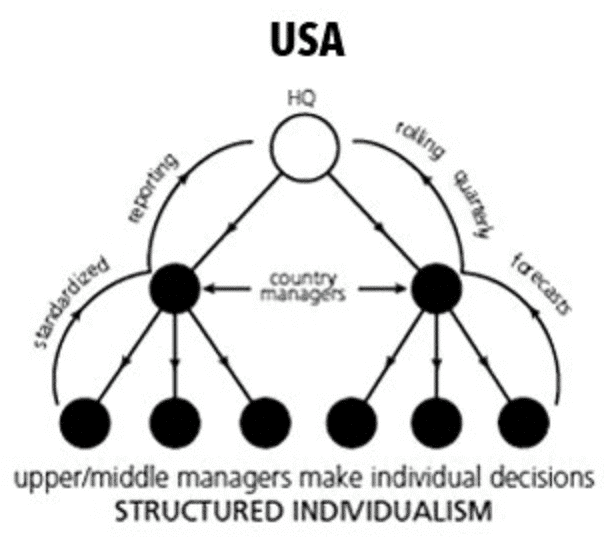A recent corporate training video from a Chinese bank has gone viral and even spread to Western media outlets, though its not generating the kind of publicity that the company or country would want. The video captures a company training session gone bad when a consultant deliberately spanks several employees for ‘poor performance.’ Apart from leaving a slightly painful mark on China’s reputation, the video is also sure to renew debates over Eastern and Western management styles. To be sure, there are some cultural differences that influence leadership styles. Yet the qualities that comprise good management are more similar across cultures than we might imagine
“Leadership style” charts produced by British linguist Richard D. Lewis and published in his book, When Cultures Collide, as reported by Business Insider.
In an article by Harvard Business Review that examined leadership skills in managers from China and the US, one similarity was identified to be that, “Nearly everyone who had done some kind of leadership development in the last two years had been focused on remediation of some weakness area.” Clearly, most people and organizations consider fixing weaknesses as being crucial to making improvements. Another interesting find was that respondents overwhelmingly agreed that, “…the ability to inspire and motivate was a critical attribute of great leaders.” Furthermore, these managers were identical in their shared valuation of a “drive for results” as the most important trait of leadership.
Where the differences in management style become more apparent are in the manager’s expectations of how their team will operate. For instance, Business Insider notes that, “American managers…are capable of teamwork and corporate spirit, but they value individual freedom.” On the other hand, “Consensus is generally highly valued in China.” Part of the reason for this difference is historical relations to the institution of government; Americans tend to view business and government as two separate spheres of society, while a great many companies and industries in China are still fully or partially state-owned. For those companies controlled by the state, a leadership group works to establish consensus on strategy, rather than a central CEO figure. But as capitalist-style companies continue to gain ground, Business Insider reports that individual “leaders are emerging with reputations of competence.” Even the control of the central government is starting to become more decentralized as local officials are ceded more business influence in place of Beijing’s formerly omnipresent role.
Suggested Reading:
From my own observations of working for Colorado companies, with Chinese start-ups, and now employed for a European company in Hong Kong, there is one consistent factor across organizational structures that cannot be fully accounted for by cultural or geographical background: the individual manager. While managers may have similar strategies and approaches, and while they may have even read the same management books, each manager has their own unique qualities and characteristics that generate a style that will always be somewhat different from their peers. Being aware of cultural nuances is important and can help guide interactions with management, but the greater benefit will be understanding the idiosyncrasies of your direct report on a more individual basis, and then configuring your relationship to be in alignment. Master this skill, and you’ll be able to work in any country on the planet.
-Sean Doherty is a Colorado native and graduate of Metropolitan State University, living and working in Hong Kong, Shanghai, and Nanjing, China. Sean represents the Denver South Economic Development Partnership as the Greater China Exchange Coordinator, focused on fostering the exchange of ideas, strategies, and talent between China and the metro-Denver area. In 2016, Sean was selected as a Jiangsu Province Youth Friendship Ambassador. He can be reached at KairosHappens@gmail.com


